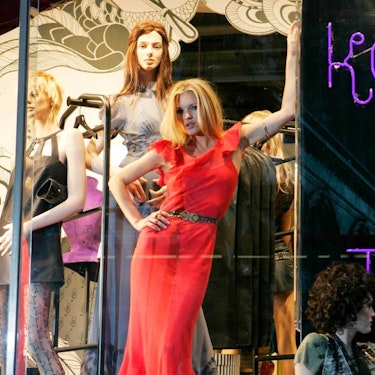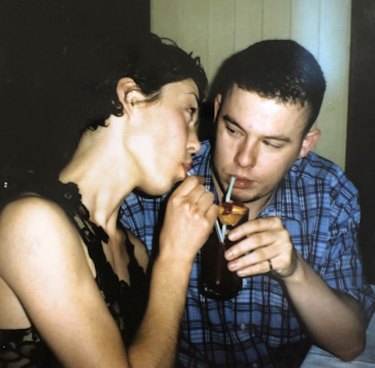Inside Aaron Esh’s camera roll

For East End designer Aaron Esh, sartorialism runs in the family. Here, we delve into the images, spaces, screenshots and memories that form his working mood board.
Style
Words: Joe Bobowicz
Photography: Alexa Rayner,
Moritz Tibes
Taken from the winter 24 print issue of THE FACE. Get your copy here.
Aaron Esh, the person and the namesake label, is all about the party. In fact, on the Tuesday morning we met the East Londoner at his Haggerston studio – it’s backed by the Sarabande Foundation, which was set up by Alexander McQueen to “support creative and visionary talent” – he’s still recovering from girlfriend Fiona Hartley’s big birthday bash in the countryside the weekend prior.
Aaron is clad in pointed Chelsea boots, distressed grey skinnies and one of his own abbreviated jackets. He offers a cup of tea before introducing a tight team of designers, each one as understated as he is. His penchant for partying isn’t quite what you’d imagine, though. Forget tar-lined warehouses or scatty squats. His are DIY soirées, where hot young things adorn themselves in Vinted couture, swill homemade martinis and chuff on Vogue cigarettes.
This sensibility was apparent in his SS25 collection, where models Jonas Glöer and Kiki Willems – who are also the designer’s neighbours – strutted down the runway wearing svelte leather trews, silky dinner jackets and gossamer satin lapels that caressed and flounced from evening gowns. Dressing upwards, if you will. “It’s not about Jonas and Kiki walking the show because they’re Jonas and Kiki,” says Aaron. “It’s because they were literally at the party we’re talking about conceptually.”
Indeed, any Dalston/Hackney/Haggerston/Hoxton regular accustomed to Aaron’s world will recognise not just faces, but traits in the clothes that make them both convincing and refreshing. Unlike a lot of East London’s creative class, it’s about young people looking older, living out their haute fantasies on a budget.
“I think the clothes I really like are from an era that’s maybe not the way I dress, or that I would be perceived to like – and I don’t know why I have that interest in it,” says Aaron, who is in his early thirties. He cites the halcyon days of ’50s couture, when Mr Cardin and Mr Dior showcased their work to a specific, highfalutin set inside the intimate confines of a Parisian salon or trunk show. This approach coloured Aaron’s AW24 showcase, where 100-something people squashed into a room at Sarabande’s headquarters, seated a knee-brushing distance from the clothes.





Working closely on his SS25 collection with industry doyenne Katy England – former right-hand stylist to McQueen – Aaron holds high standards, blending olde-worlde fashion with all the enthusiasm of his millennial peers.
Alongside zippy casting director Najia Li Saad, there’s McQueen favourite Gainsbury & Whiting producing his shows, a duality reflected in the high/low USP of his brand. Combining an expensive taste for Made In England design, the chaos of a late-stage Primrose Hill set – think Kate Moss smoking out of the window in a tabloid splash – and the finery of Parisian fashion, Aaron has birthed his own niche, one that’s attuned to the thrown-on grit and glamour he lives and breathes.
“It’s not about money. It’s not about clout. It’s just about believing in the clothes, the vision and the culture,” he says. “And I think culture is the most important word – being part of that culture, and believing in the culture, to then work on something that feels relevant and real.”
Party people


“[Najia and I] work all year round on the casting, which is quite unusual, but I really find her [to be] a collaborator as much as a casting director. For me, the context of the casting is the context of the clothes. Who is wearing them and how they’re wearing them is as important to me as the clothes themselves, and that’s what makes the fashion. It’s changed from season to season, but we spoke a lot about the party and the characters for SS25. ‘Would they be there? Who are they snogging? Who are they there with?’ You know, adding that extra layer of storytelling to the clothes.
The casting isn’t CSM, it’s not Celine… It’s its own thing – these people know each other. When we did the show, we realised that half of them had been at the pub together the night before. I said to Najia: ‘Fuckin’ ’ell, we’ve done our job well.’ One of them was dating another one. We had no idea.”
Real research
“I’ve got amazing photos of my suitcase that I brought back from Paris. I had a party at my house and everyone was rummaging through this collection that had just been on a runway, looking in the mirror and walking up and down my living room, gallivanting around. I was photographing everything, like: ‘This is real fucking research!’”
A tailored approach
“If you ask me, ‘What does it mean for me to be British?’ – in blood, I’m not English at all [he’s Cypriot/Polish], but I was born in London – my Britishness is in Savile Row and British textiles. We’re not able to hand-felt, pad and canvas all the jackets, but we’ll add as many elements that nod to Savile Row as possible – such as having striped acetate sleeves. It’s such a small detail, but if you know your shit and you open your jacket, you’re like: ‘Oh, that’s a nice touch.’ This jacket [below] is women’s and has these arm darts. It’s got this peplum room at the back and is cut cross-grain, so you have this vertical weave that goes down. It’s lined in cupro and, you know, it’s a fucking nice jacket!”
The rag trade

“[My paternal grandfather] was a trade tailor. He came from Cyprus in the ’50s and opened a bunch of dry cleaners in Islington. My aunt worked as a factory manager in Dalston in the rag trade. It was kind of my introduction to clothes. I remember being upstairs in the pattern-cutting room. It’s quite a cliché but it’s the genuine truth.”
Easy does it
“There’s an effortlessness to the things we design, in process as well. With a lot of the drapes, it’s the first one. If you overthink it, it’s going to be contrived. First idea, that’s the right one; first drawing, that’s the right one.”
Vintage couture









“[The kinds of shapes] I find very interesting [are the] egg‑y, cocoon‑y shapes. It feels very ’50s, but also very ‘I’m cold’, walking home from the night out. We really thought about brand identity and codes with Katy [England]. We had this conversation: ‘Who are we?’ And this was part of the identity. I think silhouette and eras are something that, going forward, will be referential to what we do.”
Reference rail

“[My rail] is either archives or from Vinted. This is Karen Millen and this is Kate Moss for Topshop.”
Why Kate?
“She loves clothes, right? She really loves fashion.”
Fiona Hartley







“She does all the glasses and is also a collaborator, partner and ear to issues and decisions. She’s as involved as anyone, really.”
The muses












“There are a few people – Fiona [Hartley] is one of them [the stylist], James Parkes [image consultant], Ch’lita [Collins], Wolf and Lux [Gillespie – Katy England’s kids] – who are quintessentially cool because of their lack of effort. You know, they can wear their Brandy Melville in a way that feels hot, but it’s actually a £10 T‑shirt.”
Raised on Raf











“These were real clothes. I was like: ‘Oh, I get it. I understand what fashion is.’ It’s not dresses. I knew who that skate kid was walking down Raf Simons’s runway with his hoodie on and the holes and the graphic print. And I then started to understand what visual identity is and how he was taking a subculture and putting that onto a Parisian runway.”
Katy England’s lock-up

“Going through her archive was the most incredible experience. It’s like being at a fucking museum. But I think her attitude to the clothes was so inspiring. Like this original Margiela jacket that Lee [McQueen] had given her: ‘Let’s try that on.’ We got a model, tried all these clothes on. [Then she said:] ‘Oh, this isn’t working.’ And she threw it to the side! They’re just clothes, right?”
Fashion is...







“When someone gets dressed in the morning, they’re making a statement. How they dress is coded. What political value do you have? What music do you listen to? What’s your gender? There’s a great book by Ted Polhemus [Streetstyle, 1994]. I wrote part of my dissertation about it for my BA. He speaks about these subjects really deeply. I think they’re relevant because we all love fab clothes, but we get dressed every day. What you’re saying [with what you wear] is, ultimately, why fashion exists.”
Outside fashion


“My time that I spend away from work is therapeutically different to anything to do with fashion. Like, my YouTube is golf. I’ve not swung a golf club in my life, but I just got really obsessed with watching these golf YouTubers. And obviously Arsenal and football are a big part of my life, and gaming, films… They’re hobbies to appease my ADHD.”
Before art school





“I’ve got a photo of me at a friend’s [opposite page, centre]. I think it was their bar mitzvah, so I must have been 13 or 14. I’m in cargo shorts, Bape trainers, a N.E.R.D. cap and a big sweatband up my arm because I was so obsessed with Pharrell. It was like: ‘Oh, I understand why I love clothes and style so much.’ It’s worlds away, but it isn’t – it’s style and culture.”




























































